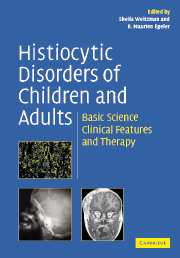Book contents
- Frontmatter
- Contents
- List of contributors
- Preface
- 1 Histiocytic disorders of children and adults: introduction to the problem, overview, historical perspective and epidemiology
- 2 The diagnostic histopathology of Langerhans cell histiocytosis
- 3 Histiocyte function and development in the normal immune system
- 4 The immunological basis of Langerhans cell histiocytosis
- 5 The genetics of Langerhans cell histiocytosis
- 6 Langerhans cell histiocytosis: a clinical update
- 7 Histiocytosis of the skin in children and adults
- 8 Langerhans cell histiocytosis of bone
- 9 Special aspects of Langerhans cell histiocytosis in the adult
- 10 Adult lung histiocytosis
- 11 Central nervous system disease in Langerhans cell histiocytosis
- 12 The treatment of Langerhans cell histiocytosis
- 13 Treatment of relapsed and/or refractory Langerhans cell histiocytosis
- 14 Late effects of Langerhans cell histiocytosis and its association with malignancy
- 15 Uncommon histiocytic disorder: the non-Langerhans cell histiocytoses
- 16 The histopathology of hemophagocytic lymphohistiocytosis
- 17 Genetics and pathogenesis of hemophagocytic lymphohistiocytosis
- 18 Clinical aspects and therapy of hemophagocytic lymphohistiocytosis
- 19 Secondary haemophagocytic syndromes associated with rheumatic diseases
- 20 Malignancies of the monocyte/macrophage system
- 21 Psychosocial aspects of the histiocytic disorders: staying on course under challenging clinical circumstances
- Index
- Plate section
3 - Histiocyte function and development in the normal immune system
Published online by Cambridge University Press: 27 August 2009
- Frontmatter
- Contents
- List of contributors
- Preface
- 1 Histiocytic disorders of children and adults: introduction to the problem, overview, historical perspective and epidemiology
- 2 The diagnostic histopathology of Langerhans cell histiocytosis
- 3 Histiocyte function and development in the normal immune system
- 4 The immunological basis of Langerhans cell histiocytosis
- 5 The genetics of Langerhans cell histiocytosis
- 6 Langerhans cell histiocytosis: a clinical update
- 7 Histiocytosis of the skin in children and adults
- 8 Langerhans cell histiocytosis of bone
- 9 Special aspects of Langerhans cell histiocytosis in the adult
- 10 Adult lung histiocytosis
- 11 Central nervous system disease in Langerhans cell histiocytosis
- 12 The treatment of Langerhans cell histiocytosis
- 13 Treatment of relapsed and/or refractory Langerhans cell histiocytosis
- 14 Late effects of Langerhans cell histiocytosis and its association with malignancy
- 15 Uncommon histiocytic disorder: the non-Langerhans cell histiocytoses
- 16 The histopathology of hemophagocytic lymphohistiocytosis
- 17 Genetics and pathogenesis of hemophagocytic lymphohistiocytosis
- 18 Clinical aspects and therapy of hemophagocytic lymphohistiocytosis
- 19 Secondary haemophagocytic syndromes associated with rheumatic diseases
- 20 Malignancies of the monocyte/macrophage system
- 21 Psychosocial aspects of the histiocytic disorders: staying on course under challenging clinical circumstances
- Index
- Plate section
Summary
Introduction
Histiocytes, represent the cells of the mononuclear phagocyte system (MPS) that can give rise to histiocytoses when they accumulate pathogenically in tissues due to dysregulation of proliferation or survival. This nomenclature may be somewhat misleading as histiocytes, in the strict sense, are macrophages located in connective tissue. However, macrophages and dendritic cells (DC) of different origins, which now are joined in the MPS, can give rise to different forms of histiocytosis, and this deviation is not restricted to connective tissue macrophages. As no alternative term exists that better describes the aberrant accumulation of mononuclear phagocytes, the term ‘histiocytes’ in the current context thus indicates mononuclear phagocytes in general.
Heterogeneity of the MPS
The MPS consists of hematopoietic cells with very diverse characteristics, originally recognized as related cells on the basis of a common lineage derivation and primary function of endocytosis (van Furth et al., 1972; van Furth, 1980). In general, cells of the MPS originate in bone marrow and migrate as monocytes through the blood to peripheral tissues, where they develop into mature cells with different features depending on tissue-specific environmental conditions. Macrophages occur virtually in all organs. Moreover, each organ contains multiple, phenotypically different macrophage subpopulations. For example, lung hosts at least two different macrophage types: alveolar macrophages in alveolar spaces and interstitial macrophages integrated in the tissue. Microglia are phagocytes of the nervous tissue, osteoclasts of bone and Kupffer cells of liver.
Information
- Type
- Chapter
- Information
- Histiocytic Disorders of Children and AdultsBasic Science, Clinical Features and Therapy, pp. 40 - 65Publisher: Cambridge University PressPrint publication year: 2005
Accessibility standard: Unknown
Why this information is here
This section outlines the accessibility features of this content - including support for screen readers, full keyboard navigation and high-contrast display options. This may not be relevant for you.Accessibility Information
- 6
- Cited by
